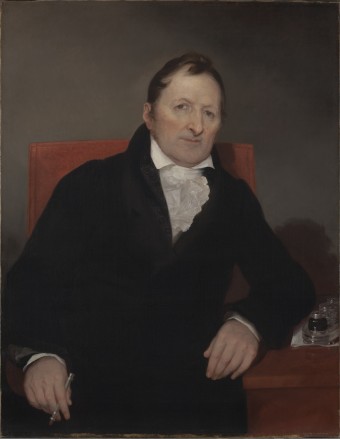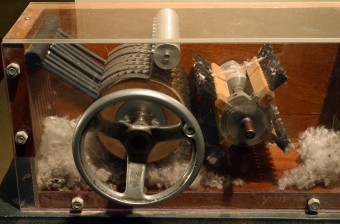Changing the World Twice- The Story of Eli Whitney
 When you hear the name Eli Whitney, you probably think of his invention, the cotton gin. But you may not realize how profoundly it (and his other inventions) changed the world. Here’s the history they never taught you in school.
When you hear the name Eli Whitney, you probably think of his invention, the cotton gin. But you may not realize how profoundly it (and his other inventions) changed the world. Here’s the history they never taught you in school.
LOOKING FOR WORK
In 1792 a 27-year-old Massachusetts Yankee named Eli Whitney graduated from Yale University and landed a tutoring job in South Carolina. He was glad to get it—he needed the money to pay off his school debts. But when he arrived there he discovered that the job paid half of what he’d been promised, which meant he’d never be able to save any money. He turned the job down.
Suddenly he was jobless, penniless, and stranded in the South, hundreds of miles from home. But he’d made the trip from New York with a friend named Phineas Miller, who was escorting his employer, a widow named Mrs. Greene, back to Georgia. When Greene invited Whitney to spend a week at her plantation outside of Savannah, he gladly accepted. He had no place else to go.
Whitney repaid Mrs. Greene’s generosity by designing an embroidery frame for her. Greene was impressed by the cleverness of the design, and it got her thinking. If Whitney was this clever, maybe he could solve a problem that plagued her and other planters—how to “gin,” or remove the seeds from, cotton…without doing it by hand.
Upland cotton, the only kind that grew in the interior regions of the South, had seeds that were “covered with a kind of green coat resembling velvet,” as Whitney put it. These fuzzy seeds stuck to the cotton fibers like Velcro. Removing them by hand required so much labor—one person could clean only about a pound of cotton per day—that upland cotton was essentially worthless.
MASS PRODUCTION
If a way could be found to remove the seeds more easily, upland cotton had the potential to become a very valuable export crop. Why? The Industrial Revolution had transformed the English textile industry (which turned the cotton into thread and the thread into cloth) into a monster and caused demand for cotton to soar.
As late as the 1730s, spinners and weavers made cloth just as they had for centuries: slowly and by hand. One person, sitting at a spinning wheel, could spin raw cotton into only one string of yarn at a time. It took 14 days to make a pound of yarn, which one or two weavers could then weave into a single piece of cloth.
In the mid-1700s, English inventions with colorful names like the flying shuttle (1733), the spinning jenny (1764), the water frame (1769), and the mule (1779), changed all that; so did the introduction of steam power in 1785. Now a single unskilled laborer—even a child or someone formerly thought too old to work—could tend machines that made hundreds and eventually thousands of strands of yarn at once, or that wove it into yards and yards of cloth, faster than the eye could see.
THE BIG BANG
Because of these inventions, the English textile industry’s appetite for cotton became enormous and grew exponentially from year to year. In 1765 spinners and weavers in England had turned half a million pounds of cotton into cloth; by 1790 the new machines were consuming 28 million pounds of cotton per year, nearly all of it imported from other countries. As demand for raw cotton soared, it got harder and harder to find enough of it to feed all of the new machines.
How much of the imported raw cotton came from the American South? Almost none. As late as 1791, the year before Whitney arrived in Georgia, exports for the entire South totaled a few hundred bags at most. But not for long.
NO PROBLEM
 So how long did it take Whitney to solve the problem that had vexed Southern planters for years? Ten days. It took several months to perfect the design, but after just 10 days, this Yankee, who’d landed at Greene’s plantation purely by chance, managed to invent this revolutionary machine.
So how long did it take Whitney to solve the problem that had vexed Southern planters for years? Ten days. It took several months to perfect the design, but after just 10 days, this Yankee, who’d landed at Greene’s plantation purely by chance, managed to invent this revolutionary machine.
The design was so simple that it was a wonder nobody else had thought of it before. It consisted of a wooden roller with wire “teeth” that grabbed the cotton fibers and pulled them through a slotted iron screen. The slots in the screen were wide enough to let the teeth and the cotton fibers through, but they were too narrow for the seeds, which separated out and fell into a box.
A rapidly rotating brush then removed the cotton fibers from the teeth and flung them into a bin. This allowed the user to feed raw cotton into the machine indefinitely, without having to stop every few minutes to clean the teeth.
Using Whitney’s cotton gin, in one day a laborer could clean as much as 10 pounds of upland cotton, which before would have taken 10 days to clean by hand. If a larger gin powered by water or a horse was used, a laborer could clean as much cotton in one day as would have taken more than seven weeks to clean by hand.
BRAVE NEW WORLD
Over the next several decades, Whitney’s cotton gin transformed the South. Tens of thousands and eventually millions of acres of wilderness were cleared to make way for enormous cotton plantations. By 1810 U.S. exports of cotton to England had grown from almost nothing to 38 million pounds, making the South the largest supplier of cotton to that country.
And that was only the beginning. By the start of the Civil War, the Southern “cotton belt,” as it came to be known, was exporting 920 million pounds of cotton to England each year, more than 90% of its cotton imports. Cotton had become, as one historian described it, “the largest single source of America’s growing wealth.” Cotton was king.
THE CLOTHES ON YOUR BACK
But Whitney’s invention had more far-reaching effects than increasing U.S. exports. The industrialization of cotton production vastly increased the supply of cotton cloth. That changed cotton from one of the most expensive fabrics on Earth to one of the cheapest—and in the process, it clothed the world.
Between 1785, the year that steam power was introduced to the textile industry, and the early 1860s, the price of cotton cloth fell by more than 99%. That’s the equivalent of a price of Tommy Hilfiger jeans falling from $5,000 to $50.
In the past almost no one had been able to afford cotton, (how many $5,000 pairs of jeans could you afford?), and things like leather and wool made poor substitutes. (Don’t believe it? Treat yourself to a pair of wool underpants and you’ll see what we mean.) “Most of humanity,” historian Paul Johnson writes in A History of the American People, “were unsuitably clothed in garments which were difficult to wash and therefore filthy.”
Cheap, abundant cotton cloth changed that, too. “There is no instance in world history where the price of a product in potentially universal demand came down so fast,” Johnson writes. “As a result, hundreds of millions of people, all over the world, were able to dress comfortably and cleanly at last.”
CHAINS OF COTTON
There is yet another aspect to Eli Whitney’s cotton gin—an ugly, inhuman side, that cast a shadow over all of the good it did. Many Americans think of Whitney’s invention as an emancipator, a machine that freed the slaves from having to do the hand ginning of cotton. On the contrary, the rise of cotton cultivation in the South actually helped to entrench the institution of slavery, condemning millions of black Americans to its horrors just when many opponents of slavery thought it might finally be dying out.
Between 1775 and 1800 the price of slaves had fallen from about $100 per slave to $50, and abolitionists predicted that if the institution were left alone, it would die on its own. Or at the very least, as slavery weakened, it would become easier to abolish.
But the invention of the cotton gin changed everything. As the amount of acreage brought under cultivation in the South soared, so did the demand for slaves to work the plantations. Between 1800 and 1850, the price of a slave rose from $50 to as much as $1,000. Slavery, formerly thought to be in decline, quickly became integral to the new Southern economy.
As such, the leaders of the Southern states became increasingly militant in their determination to defend it and even expand it beyond the South. For a new generation of Southern leaders, the institution of slavery—because of the prosperity that came with it—was something to be defended, even to the death.
The cotton gin had made it happen…and made the Civil War inevitable.
LIKE MONEY IN THE BANK
Even before Eli Whitney ginned his first handful of upland cotton, he believed that he was on his way to becoming a wealthy man. “Tis generally said by those who know anything about [the cotton gin], that I shall make a Fortune by it,” Whitney wrote in a letter to his father. His friend Phineas Miller certainly agreed—Miller became Whitney’s business partner, providing money that Whitney would use to build the machines. They would both grow rich together…or so they thought.
COPYCATS
Things didn’t work out quite as planned. There were two problems with Whitney and Miller’s dreams of grandeur:
First, just as Whitney had intended, his cotton gin was so simple and so easy to make that just about anyone who was good with tools could make one. So a lot of planters did, even though doing so violated Whitney’s patent.
Second, Whitney and Miller were too greedy for their own good. They knew that even if they had enough cash to build a cotton gin for every planter who wanted one (they didn’t), the planters didn’t have enough cash to buy them. So rather than build gins for sale, Whitney and Miller planned to set up a network of gins around the South where they would do the ginning in exchange for a share of the cotton they ginned. A big share—40%, to be exact. That was more than the planters were willing to part with, least of all to a Yankee. The planters fought back by ginning their cotton in machines they made themselves or by buying illegal copycat machines made by competitors.
And there were rumors: that Whitney himself had stolen the idea for the cotton gin from a Southern inventor; that the copycat gins were actually “improved” models that didn’t infringe on Whitney’s patents; and, worst of all, that Whitney’s machines damaged cotton fibers during the ginning process. That last rumor stuck: By the end of 1795, the English were refusing to buy cotton ginned on Whitney & Miller machines; only cotton ginned on illegal (and usually inferior) machines would do. “Everyone is afraid of the cotton,” Miller wrote in the fall of 1795. “Not a purchaser in Savannah will pay full price for it.”
COURT BATTLES
Whitney and Miller spent years battling the copycats in court and convincing the English textile mills that their cotton was still the best. The stress may have contributed to Miller’s death from fever in 1803, when he was only 39. Whitney carried on, and finally won his last court fight in 1806. But the victory came too late to do any good, because the patent on the cotton gin expired the following year. Now copying Whitney’s cotton gin wasn’t just easy, it was also perfectly legal.
So how much money did Whitney make on the invention that created huge fortunes for Southern plantation owners? Almost none. In fact, some historians estimate that after his several years of legal expenses are taken into account, he actually lost money.
The cotton gin would clothe humanity, but in the process of inventing it, Whitney had lost his shirt. “An invention can be so valuable as to be worthless to the inventor,” he groused.
THIS MEANS WAR
But Whitney was already working on another invention—one that would establish his fortune and transform the world again…even more than the cotton gin had.
In March of 1798, relations between France and the United States had deteriorated to the point that it seemed a war might be just around the corner. This presented a problem, because France was the primary supplier of arms to the United States. Where would the country get muskets now?
Congress had established two national armories beginning in 1794, but they had produced only 1,000 muskets in four years, and the government estimated that 50,000 would be needed if a war with France did come. Private contractors would have to supply the rest. Whitney, facing bankruptcy, was determined to be one of them.
ONE THING AT A TIME
Until then, all firearms were made by highly skilled artisans who made the entire weapon, crafting each part from scratch and filing and fitting them by hand. Each part, and by extension each musket, was one of a kind—the trigger made for one gun wouldn’t work on any other because it fit only that musket. Broken muskets could only be repaired by expert craftsmen. If the weapon broke in the middle of a military campaign, you were out of luck. Armorers capable of such skill were scarce, and new ones took forever to train, which was why the U.S. arsenals were having such a hard time making muskets.
IF YOU’VE SEEN ONE, YOU’VE SEEN THEM ALL
Whitney proposed a new method of making muskets, one he’d been thinking about since trying to speed up production of his cotton gins:
- Instead of using one expert craftsman to make an entire gun, he would divide the tasks among several workers of average skill. They’d be easier to train, and easier to replace if they quit.
- Each worker would be taught how to make one part. They would use special, high-precision machine tools, designed by Whitney.
- The tools would be so precise that the parts would be virtually identical to each other. Each part would fit interchangeably in any of the muskets made in Whitney’s factory.
- Once the pieces for a musket had been made, assembling them into the finished weapon would be—literally—a snap.
- Ready-made interchangeable spare parts would make it possible for any soldier to fix his musket himself.
BETTER LATE THAN NEVER
On June 14, 1798, Whitney signed a contract with the U.S. government to deliver 10,000 muskets within two years. But the war with France never came. Good thing, too, because Whitney missed his deadline by eight years. Supply shortages and yellow fever epidemics disrupted the schedule, so it took him longer to make his machine tools than he originally thought.
Whitney’s reputation as a genius helped him to get extensions and advances against his government contract. But more than anything, what gave Whitney freedom to take the time necessary to perfect his new system was a demonstration he gave to President-elect Thomas Jefferson and other high officials in 1801. Dumping a huge pile of interchangeable musket parts onto a table, Whitney invited them to pick pieces from the pile at random and assemble them into complete muskets. For the first time in history, they could.
THE AMERICAN SYSTEM
It may not sound like a big deal, but it was. Whitney had devised a method of manufacturing more muskets of higher quality, in less time and for less money, than had ever been possible before. And he did it without the use of highly skilled labor. Once again, Whitney had invented something that would change the world.
What worked with muskets would also work with clothing, farm equipment, furniture, tools, bicycles, and just about anything else people could manufacture. Whitney called his process “the American system.” Today it’s known as mass production. In time it would overshadow even the cotton gin itself in the way it would transform the American economy.
Only this time, the transformation would be felt most in the North…and it would bring the South to its knees.
 This article is reprinted with permission from The Best of the Best of Uncle John’s Bathroom Reader. They’ve stuffed the best stuff they’ve ever written into 576 glorious pages. Result: pure bathroom-reading bliss! You’re just a few clicks away from the most hilarious, head-scratching material that has made Uncle John’s Bathroom Reader an unparalleled publishing phenomenon.
This article is reprinted with permission from The Best of the Best of Uncle John’s Bathroom Reader. They’ve stuffed the best stuff they’ve ever written into 576 glorious pages. Result: pure bathroom-reading bliss! You’re just a few clicks away from the most hilarious, head-scratching material that has made Uncle John’s Bathroom Reader an unparalleled publishing phenomenon.
Since 1987, the Bathroom Readers’ Institute has led the movement to stand up for those who sit down and read in the bathroom (and everywhere else for that matter). With more than 15 million books in print, the Uncle John’s Bathroom Reader series is the longest-running, most popular series of its kind in the world.
If you like Today I Found Out, I guarantee you’ll love the Bathroom Reader Institute’s books, so check them out!
| Share the Knowledge! |
|




